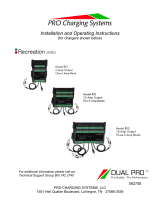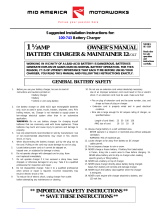
2
B. PERSONAL PRECAUTIONS AND SAFETY
1. Wear complete eye protection and clothing protection when
working with lead-acid batteries.
2. Makesuresomeone is withinrange of yourvoiceor close
enough to come to your aid when you work with or near a
lead-acid battery.
3. Have plenty of fresh water and soap nearby for use if battery
acid contacts skin, clothing, or eyes. If battery acid contacts
skin or clothing, wash immediately with soap and water.
4. Avoidtouchingyoureyeswhileworkingwithabattery.Acid
particles(corrosion)maygetintoyoureyes!Ifacidentersyour
eye,immediatelyoodeyewithrunningcoldwaterforatleast
10 minutes. Get medical attention immediately.
5. Remove all personal metal items such as rings, bracelets,
necklaces, and watches when working with a lead-acid battery.
Alead-acidbatterycanproduceashort-circuitcurrenthigh
enoughtoweldaring(orthelike)tometal,causingasevere
burn.
6. Take care not to drop a metal tool or other metal onto the
battery.Metalmaycausesparkingorshortcircuitthebatteryor
another electrical device. Sparking may cause an explosion.
7. Alwaysoperatebatterychargerinanopen,well-ventilated
area.
8. NEVERsmokeorallowasparkorameinthevicinityofthe
battery or engine. Batteries generate explosive gases.
9. NEVERchargeafrozenbattery.
10. Alwaysunplugchargeraftereachuse.
WARNING: EXTERNAL CONNECTIONS TO CHARGER SHALL
COMPLY WITH THE UNITED STATES COAST GUARD ELEC-
TRICAL REGULATIONS (33CFR183, SUB PART1).
C. PREPARING TO CHARGE
1. If necessary to remove battery from boat or vehicle to charge,
always remove grounded terminal from battery rst. Make
sure all accessories in the boat or vehicle are off, so as not
to cause an arc.
2. Clean battery terminals. Take care to keep corrosion from
coming in contact with your eyes.
3. If required, add distilled water in each cell until battery acid
reacheslevelsspeciedbybatterymanufacturer.Thishelps
purge excess gas from cells. Do not overll. For a battery
without cell caps, carefully follow manufacturer’s recharging
instructions.
4. Study all battery manufacturers’ specic precautions, such
as removing or not removing cell caps while charging, and
recommended rates of charge.
5. Be sure area around battery is well ventilated while battery
isbeingcharged.Usingapieceofcardboardorothernon-
metallic material as a fan can forcefully blow gas away.
D. CHARGER LOCATION
Donotrestricttheairowunderthecharger.Donotmountthe
charger next to fuel tanks or below the waterline of the boat.
The charger is waterproof and is approved for mounting on the
weatherdeck.
To allow for proper air circulation, a minimum of four inches of un-
obstructed area must be permitted on all sides of the charger.
Chose a location such that the six-foot cables can reach the
battery(ies). If extra length is needed, bring the ring lugs to a
terminal block and extend with a minimum of 14AWG cables.
Chooselargerwireforextendedruns.
The charger weight is substantial. Ensure that the mounting sur-
faceisstrongenoughtosupportthecharger.Choosealocation
thatwillallowforallfourmountingholestobeused.Mountingwith
nuts, bolts and lock washers is preferable to screws.
Never place the charger directly above the battery being charged;
gases may harm the charger over time. Never allow acid to drip on
thechargerwhenreadingspecicgravityorllingbattery.
Do not set a battery or any other object on top of charger.
E. MOUNTING INSTRUCTIONS
The charger may be permanently mounted and connected. Four
mountingholeshavebeenprovidedforsecureinstallation.Choose
alocationforthecharger(see“CHARGERLOCATION”forproper
placement).Usingthechargerasatemplate,placethecharger
in the selected location and mark each of the four holes with a
pencil. In a well ventilated environment, drill the four holes using a
#9(7/32”)drillbitforusewithnutsandboltsORwitha5/32”drill
bit for use with #10 self tapping screws. Take caution of the area
on the other side that you are drilling to avoid drilling into wires or
othercomponents.Using#10bolts,nutsandlockwashers,mount
thechargerwiththeLEDsfacinguponaatverticalsurfaceto
allowforventilation.RoutetheACandDCcordstoeither end
andavoidpinchingthemunderthebase.Asealantmaybeused
to waterproof the screw holes.





